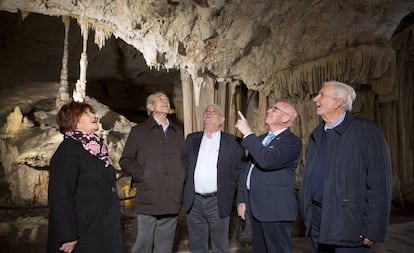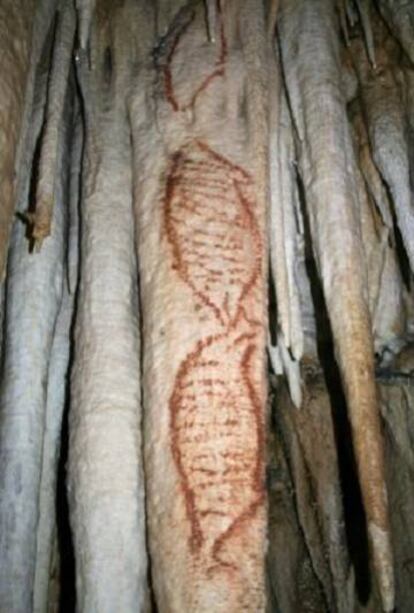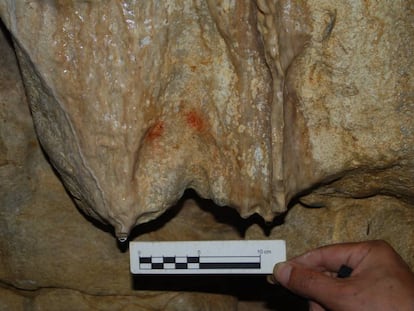Bats and skeletons: how five kids discovered a priceless cave in Spain
This year marks the 60th anniversary of the random find by a group of youths from Nerja, in Málaga

The youngsters were looking for bats. They spied a few emerging from a crack, and decided to step into the heart of the mountain to see where the animals lived.
Everything was going well until the five friends ran into several stalactites and stalagmites blocking their way. Undeterred, the little group returned the next day armed with a hammer and a couple of flashlights.
I remember I was very scared
José Luis Barbero
After breaking their way through, the young explorers found themselves inside a large hollow space filled with strange rock formations. And then they found two skeletons. They began to panic.
“What if we had ended up trapped in there as well?” wonders José Torres, who was 16 when he and his friends unwittingly discovered the cave of Nerja in 1959.
The cave, located within Málaga province in southern Spain, is of great interest to scientists, as its rock formations go back 800,000 years. It also contains a huge gallery of prehistoric art made up of nearly 600 motifs. It was declared a Cultural Interest Site in 1985 and an archeology zone in 2005.

Next January 12 marks the 60th anniversary of the discovery by the group of adventurous teens, and the foundation that manages the site has prepared a tribute for them. Besides representing the town of Nerja at the next FITUR international tourism fair, during the month of April they will serve as guides to cave visitors.
Today, around a third of the 300,000 square meter space is open to visitors, and 450,000 people buy a ticket each year. Only the Picasso Museum in Málaga city attracts more tourists.
Experts believe that the cave was inhabited 25,000 years ago, although ongoing studies suggest there may have been humans there as early as 40,000 years ago. Every other week, a new object is found at the site that sheds new light on various periods of early human history. These artifacts are kept at the Nerja musem.
José Torres had arrived in Nerja with his family after his father, a Civil Guard officer, was sent there. His new friends said they wanted to show him a magical place that they had explored superficially years earlier.
The leader of the group was Francisco Navas, then 21 and the oldest of them all. There was also Manuel Muñoz, 18, and his brother Miguel, 13. “I was very scared,” recalls the latter. The fifth explorer, José Luis Barbero, who was 15 at the time, passed away in 2007.
When they emerged from the cave and told people that they had found some skeletons, nobody would believe them except for their schoolteacher, Carlos Saura. The story spread, and on June 12, 1960 the cave was first opened to the public. That year also marked the beginning of a music and dance festival that continues to take place every year since then.
The youths began working as tour guides in the cave. “We took a course because we knew nothing about speleology, or about anything that was inside the cave for that matter,” recalls Manuel Muñoz.
Some of them moved on to other jobs a few years later, but others like Muñoz devoted their entire professional lives to the cave. And all five of them have at least one child who is now working there.
They are “incredibly proud” of their discovery even though it was “random luck, an accumulation of circumstances,” admits Francisco Navas.
These days, there is a monument to the five men outside the entrance where they first went in, embarking on an adventure that would change their lives.
English version by Susana Urra.
Tu suscripción se está usando en otro dispositivo
¿Quieres añadir otro usuario a tu suscripción?
Si continúas leyendo en este dispositivo, no se podrá leer en el otro.
FlechaTu suscripción se está usando en otro dispositivo y solo puedes acceder a EL PAÍS desde un dispositivo a la vez.
Si quieres compartir tu cuenta, cambia tu suscripción a la modalidad Premium, así podrás añadir otro usuario. Cada uno accederá con su propia cuenta de email, lo que os permitirá personalizar vuestra experiencia en EL PAÍS.
¿Tienes una suscripción de empresa? Accede aquí para contratar más cuentas.
En el caso de no saber quién está usando tu cuenta, te recomendamos cambiar tu contraseña aquí.
Si decides continuar compartiendo tu cuenta, este mensaje se mostrará en tu dispositivo y en el de la otra persona que está usando tu cuenta de forma indefinida, afectando a tu experiencia de lectura. Puedes consultar aquí los términos y condiciones de la suscripción digital.
More information
Archived In
Últimas noticias
The new victims of the Republican war on Obamacare: Millions hit by soaring health insurance premiums
A country divided on migrant rights: Some US states expand protections while others restrict them
Venezuela authorizes the release of another 87 political prisoners
There is as much life left to discover on planet Earth as that which is already known
Most viewed
- David King, chemist: ‘There are scientists studying how to cool the planet; nobody should stop these experiments from happening’
- Reinhard Genzel, Nobel laureate in physics: ‘One-minute videos will never give you the truth’
- Oona Chaplin: ‘I told James Cameron that I was living in a treehouse and starting a permaculture project with a friend’
- Sinaloa Cartel war is taking its toll on Los Chapitos
- The Interoceanic Train, the Mexican alternative to the Panama Canal











































